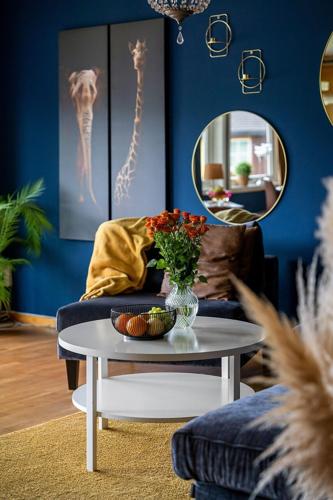In the realm of interior design, creating a space that reflects personal style yet remains functional can be a delicate balance. Understanding key design principles and trends can elevate any room from mundane to stunning. Whether it’s a living room, bedroom, or hallway, making each area stylish requires thoughtful considerations and a few design secrets that can truly transform your home.

Emphasize Your Focal Points
Every room should have a focal point that draws the eye and sets the tone for the rest of the décor. This could be a grand piece of art, a beautifully designed fireplace, or stunning architectural features. Strategically placing lighting around these focal points can enhance their impact. For instance, using spotlights or wall sconces can highlight a piece of artwork, creating a sense of drama in the space.
Incorporating large furniture pieces can create focal points. Oversized sofas or statement chairs in a living room can be positioned to invite conversation while simultaneously showcasing their design. Balancing these features with surrounding décor helps unify the space, allowing the focal point to shine without overwhelming the room.
Color Schemes Matter
The colors you choose can significantly affect the mood and feel of a room. Warm colors like reds, oranges, and yellows can create an inviting atmosphere, while cool colors such as blues, greens, and purples evoke calmness and serenity. One effective strategy is to select a primary color and use it in various shades and tones throughout the space. This provides cohesion and adds depth and interest.
Accent walls can be used to play with bold colors without committing to a fully colorful room. Incorporating patterns in throw pillows, rugs, or artwork allows for personalization while maintaining harmony through a consistent color palette.
Textures and Patterns
Mixing textures and patterns adds dimension and interest to a room. Soft textiles like velvet and silk can create a luxurious feel, while natural materials such as wood or stone can bring an organic touch. Layering textiles in a living area, such as combining a chunky knit throw on a soft cotton sofa, generates comfort. The juxtaposition of hard and soft materials can draw attention and create a welcoming atmosphere.
When it comes to patterns, don’t shy away from mixing them up. Combining geometric shapes with floral prints can add a dynamic touch to your décor. The key is to maintain a consistent color scheme that ties the different patterns together, ensuring they complement rather than clash with one another.
Incorporate Functional Decor
Decor doesn’t just have to be about aesthetics. It can serve a purpose. Functional decor provides utility without compromising on style. Consider elements like stylish shelving that functions as a bookcase or a radiator cover that acts as a table.
More subtly, integrating custom stair runners into your hallways adds a style factor and enhances safety on stairs. As explained by experts from Direct Carpet, custom stair runners can reflect your color scheme and personal taste, contributing to a coherent theme while serving their necessary function. Using decorative storage can declutter your space while enhancing its appeal.
Baskets, decorative boxes, and stylish furniture with built-in storage help maintain an organized look, allowing the beautiful elements of your decor to stand out. This thoughtful integration ensures that style doesn’t compromise functionality.
Personal Touches Make It Home
Adding personal touches is what makes a house feel like a home. Displaying items that reflect your personal history or travels can inspire conversation and add character to your decor. Family photographs, travel souvenirs, and handmade pieces all contribute to a unique atmosphere that tells a story.
Art selection should be deliberate and meaningful. Whether it’s an original piece or a print, art can set the mood and convey one’s personality. Try to curate art that resonates with you and complements the surrounding decor, creating an inviting space that feels warm and welcoming.
Lighting as a Design Tool
Lighting plays a crucial role in shaping the ambiance of a room. Natural light is often ideal, so consider window treatments that allow plenty of sunlight to filter in. For the evenings or darker spaces, layered lighting is important. Combining overhead lighting with floor lamps and accent lighting allows for flexibility while creating atmosphere.
Investing in statement light fixtures, such as a unique chandelier or pendant lamp, can serve as a focal point. These pieces can elevate the design while offering functionality, demonstrating that lighting can be art.

Sustainable Design Choices
In today’s ecological climate, sustainable design choices are more important than ever. Opting for eco-friendly materials, like reclaimed wood or recycled textiles, reduces the environmental impact and contributes to the style of your space. Many manufacturers offer sustainable options that do not sacrifice design, allowing homeowners to prioritize their values without compromising aesthetic appeal.
Incorporating houseplants can enhance indoor air quality and throw in a pop of color. Plants bring life and freshness while enhancing the decor naturally. Mixing various plants with different textures creates visual interest and emphasizes the beauty of nature inside your home.
Balancing Space and Proportion
Achieving a sense of balance and proportion is key to creating a harmonious interior. Every piece of furniture and décor should relate to the room’s scale to maintain visual cohesion. Oversized furniture in a small space can make it feel cramped, while too many small pieces in a large room can appear scattered and unfinished.
A well-proportioned design ensures that each element, whether it’s a sofa, coffee table, or piece of art, complements the overall layout rather than competing for attention. Using symmetry, such as pairing side tables or matching lamps, can enhance balance and create a polished, intentional look. Thoughtfully arranging furniture to maintain open pathways contributes to better flow, ensuring your room feels both elegant and functional.
The combination of thoughtful design principles can transform any room into a striking environment that reflects your personal style. By emphasizing focal points, choosing the right color schemes, and integrating both functional and decorative elements, anyone can create a stylish haven. Remember that personal touches, effective lighting, and sustainable choices can enhance these efforts, making every space truly your own.






(0) comments
We welcome your comments
Log In
Post a comment as Guest
Keep it Clean. Please avoid obscene, vulgar, lewd, racist or sexually-oriented language.
PLEASE TURN OFF YOUR CAPS LOCK.
Don't Threaten. Threats of harming another person will not be tolerated.
Be Truthful. Don't knowingly lie about anyone or anything.
Be Nice. No racism, sexism or any sort of -ism that is degrading to another person.
Be Proactive. Use the 'Report' link on each comment to let us know of abusive posts.
Share with Us. We'd love to hear eyewitness accounts, the history behind an article.